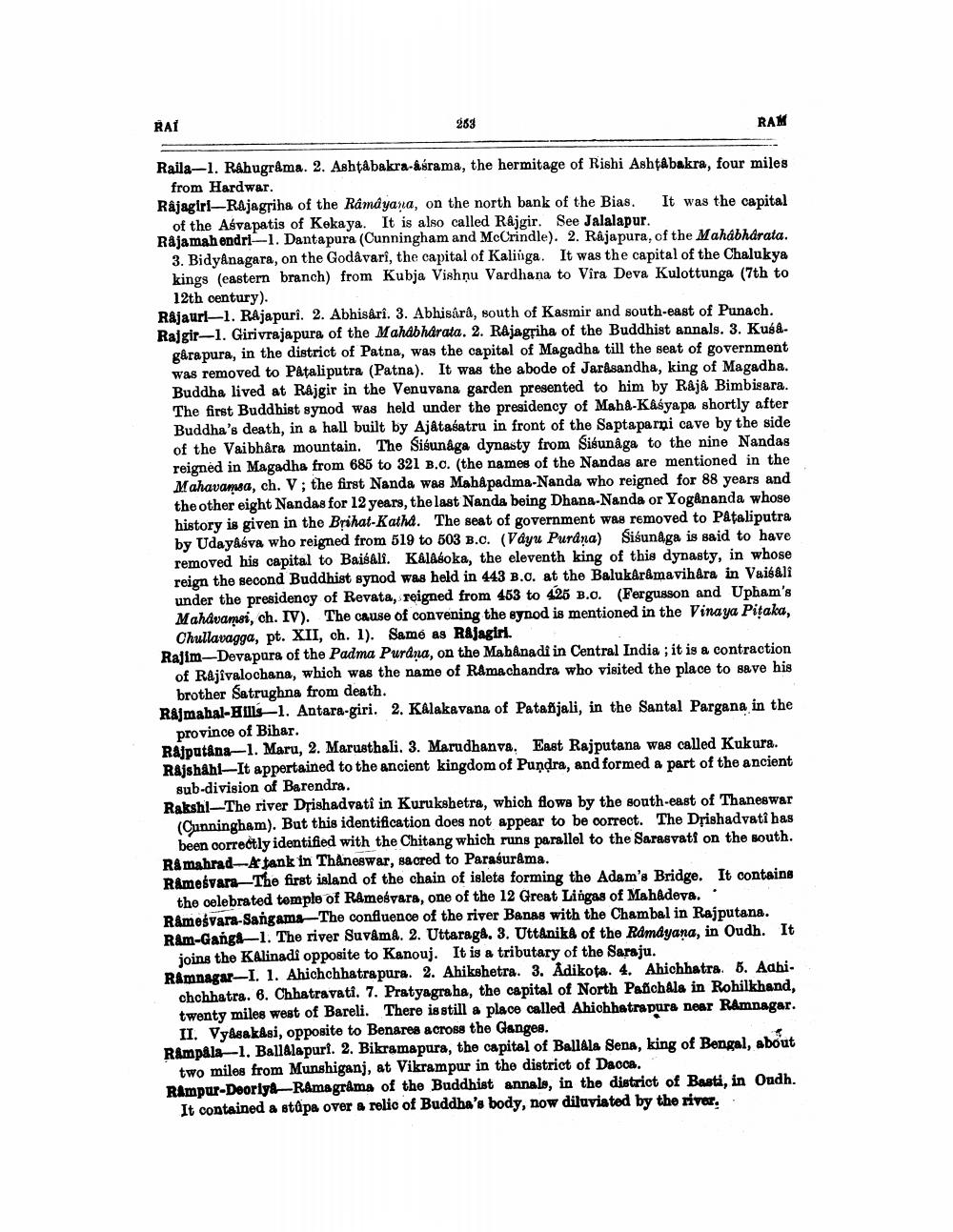________________
RAI
263
RAM
Raila-1. Rahugræma. 2. Ashtabakra-asrama, the hermitage of Rishi Ashtabakra, four miles
from Hardwar. Rajagiri-Rajagriha of the Ramayana, on the north bank of the Bias. It was the capital
of the Asvapatis of Kekaya. It is also called Rajgir. See Jalalapur. Rajamahendri-1. Dantapura (Cunningham and McCrindle). 2. Rajapura, of the Mahabharata.
3. Bidyânagara, on the Godavari, the capital of Kalinga. It was the capital of the Chalukya kings (eastern branch) from Kubja Vishņu Vardhana to Vira Deva Kulottunga (7th to
12th century). Rajaurl-1. Rajapuri. 2. Abhisari. 3. Abhisára, south of Kasmir and south-east of Punach. Rajgir-1. Girivrajapura of the Mahabharata. 2. Rajagriha of the Buddhist annals. 3. Kusa.
gåra pura, in the district of Patna, was the capital of Magadha till the seat of government was removed to Pataliputra (Patna). It was the abode of Jarasandha, king of Magadha. Buddha lived at Rajgir in the Venuvana garden presented to him by Rajâ Bimbicara. The first Buddhist synod was held under the presidency of Maha-Kaśyapa shortly after Buddha's death, in a hall built by Ajátasatru in front of the Saptaparņi cave by the side of the Vaibhåra mountain. The Sisunaga dynasty from Sisunaga to the nine Nandas reigned in Magadha from 685 to 321 B.C. (the names of the Nandas are mentioned in the Mahavamsa, ch. V; the first Nanda was Mahapadma-Nanda who reigned for 88 years and the other eight Nandas for 12 years, the last Nanda being Dhana-Nanda or Yogananda whose history is given in the Brihat-Katha. The seat of government was removed to Pataliputra by Udayâsva who reigned from 519 to 503 B.C. (Vayu Purdna) Sisunaga is said to have removed his capital to Baibali. Kaldboka, the eleventh king of this dynasty, in whose reign the second Buddhist synod was held in 443 B.C. at the Balukâråmavihara in Vaisali under the presidency of Revata, reigned from 453 to 4.25 B.O. (Fergusson and Upham's Mahavamsi, ch. IV). The cause of convening the synod is mentioned in the Vinaya Pitaka,
Chullavagga, pt. XII, ch. 1). Same as Rajagiri. Rajim-Devapura of the Padma Purana, on the Mahanadi in Central India ; it is a contraction
of Rajivalochana, which was the name of Ramachandra who visited the place to save his
brother Satrughna from death. Rajmahal-Hills-1. Antara-giri. 2. Kalakavana of Patanjali, in the Santal Pargana in the
province of Bihar. Rajputana-1. Maru, 2. Maruathali. 3. Marudhanva. East Rajputana was called Kukura. Rajshahi-It appertained to the ancient kingdom of Pundra, and formed a part of the ancient
sub-division of Barendra. Rakshl—The river Drishadvatî in Kurukshetra, which flows by the south-east of Thaneswar
(Cunningham). But this identification does not appear to be correct. The Drishadvatî has
been correctly identified with the Chitang which runs parallel to the Sarasvati on the south. Rå mahrad-Ajank in Thaneswar, sacred to Parasurama. Rámesvara-The first island of the chain of islets forming the Adam's Bridge. It contains
the celebrated temple of Ramešvara, one of the 12 Great Lingas of Mahadeva.. R&mesvara-Sangama-The confluence of the river Banas with the Chambal in Rajputana. Rám-Gang -1. The river Suvama. 2. Uttaraga. 3. Uttanikå of the Ramayana, in Oudh. It
joins the K Alinadi opposite to Kanouj. It is a tributary of the Saraju. Ramnagar-I. 1. Ahichchhatrapura. 2. Ahikshetra. 3. Adikota. 4. Ahichhatra. 6. Aabi.
chchhatra. 6. Chhatravati. 7. Pratyagraha, the capital of North Pañch Als in Rohilkhand. twenty miles west of Bareli. There is still a place called Ahichhatrapura near Ramnagar.
II. VyfsakAsi, opposite to Benares across the Ganges. Rampala--1. Ballalapurf. 2. Bikramapura, the capital of BallAla Sena, king of Bengal, about
two miles from Munshiganj, at Vikrampur in the district of Daoca. Rampur-DoorlyaRamagrama of the Buddhist annals, in the district of Basti, in Oudh.
It contained a stapa over a relic of Buddha's body, now diluviated by the river.




